Research Project: Equality and Diversity within an Organisation
VerifiedAdded on 2023/01/09
|29
|6839
|57
Project
AI Summary
This research project investigates the significance of equality and diversity within organizations, with a specific focus on GlaxoSmithKline (GSK). The project begins with an introduction and a detailed literature review, exploring the conceptual framework of equality and diversity in a business context. The study examines the rationale for managing cultural diversity, its impact on organizational productivity, and the interrelationship between cultural diversity and GSK's performance. The research methodology employs a quantitative approach, utilizing a deductive approach and positivism philosophy to analyze data. The project includes a discussion of costs, access, and ethical considerations, followed by data analysis and findings. The research aims to understand how GSK manages diversity and its influence on business operations, with objectives that include understanding the conceptual framework, assessing the need for cultural diversity management, determining the interrelationship between cultural diversity and performance, and articulating measures for developing business performance. The project concludes with a discussion of the research outcomes, conclusions, and recommendations, along with a reflection on the project and a comprehensive list of references.
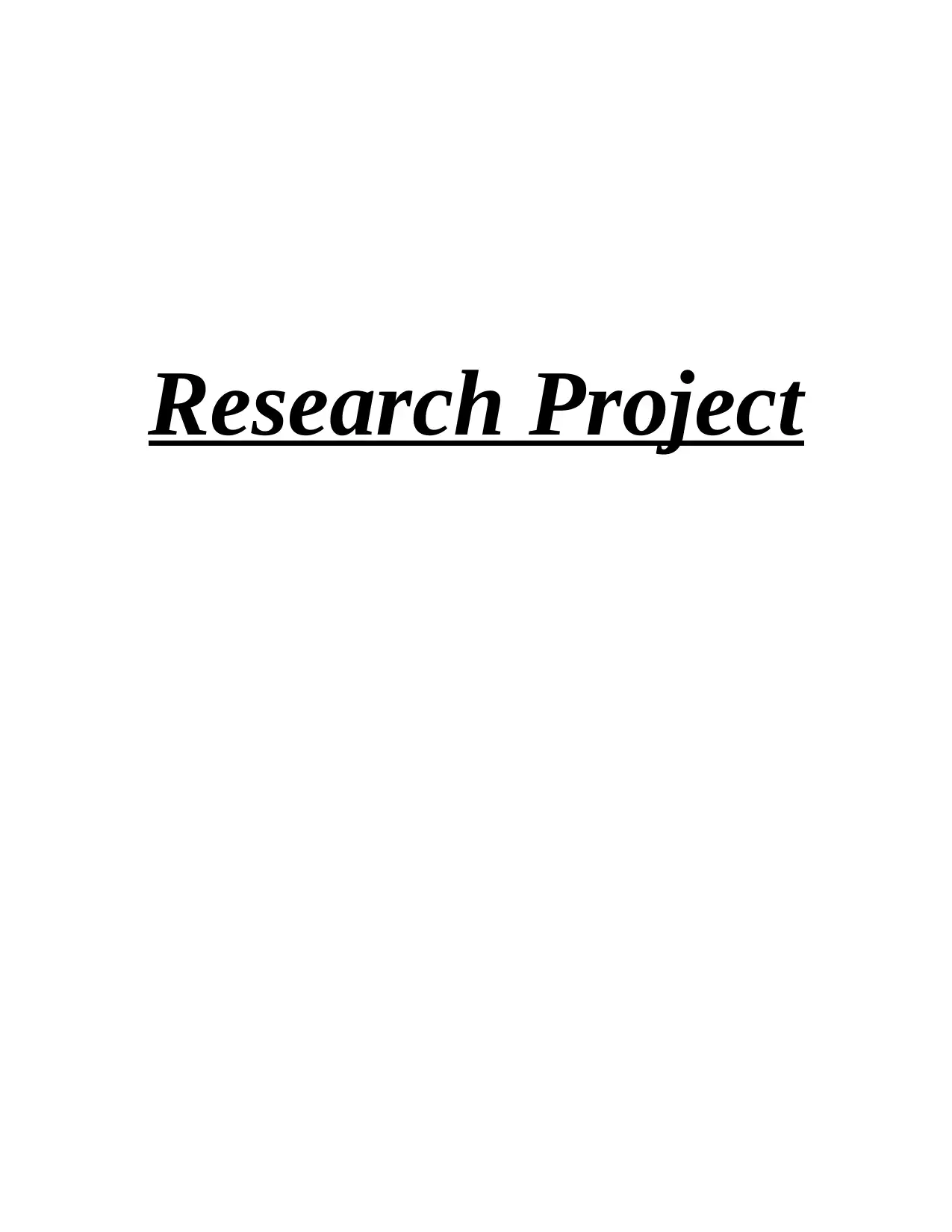
Research Project
Paraphrase This Document
Need a fresh take? Get an instant paraphrase of this document with our AI Paraphraser
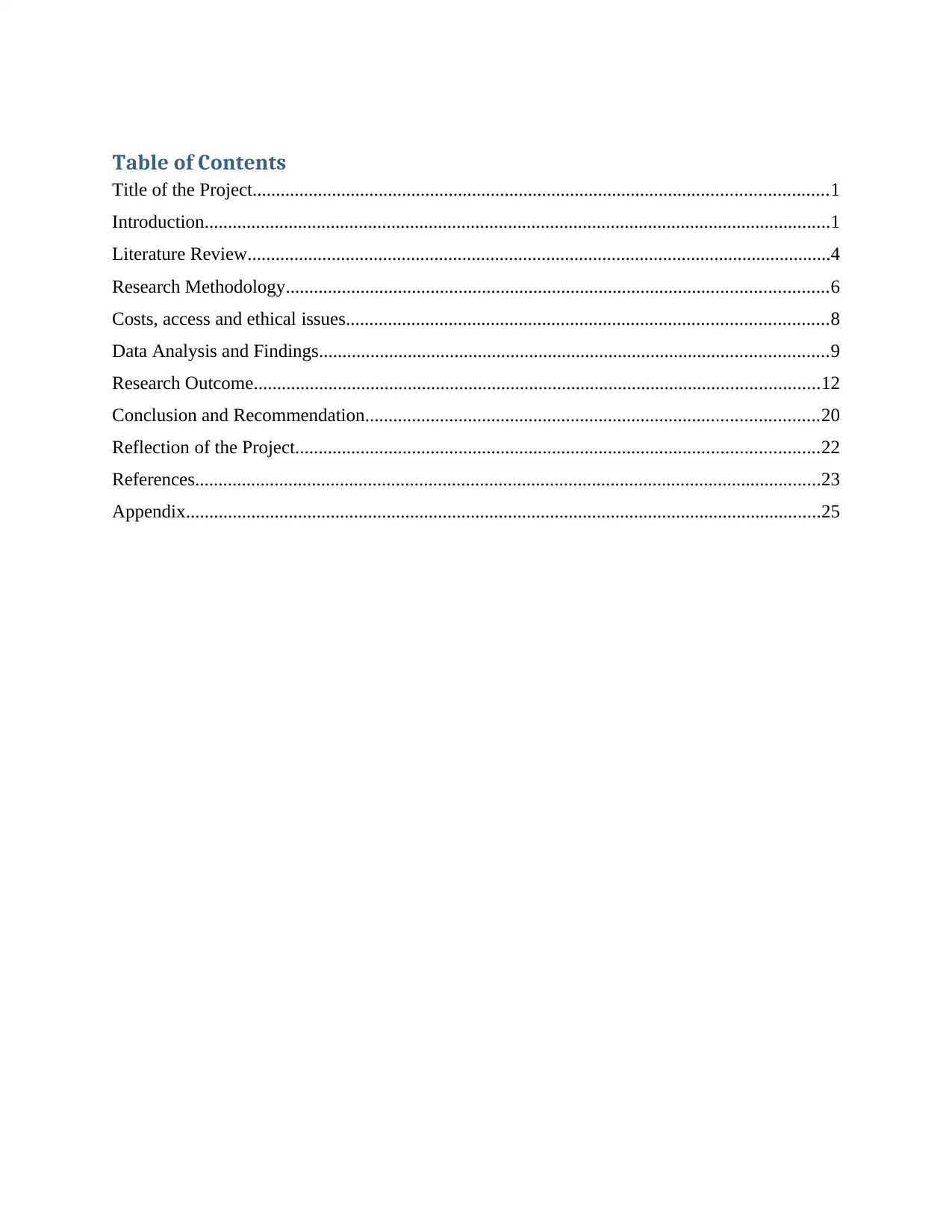
Table of Contents
Title of the Project...........................................................................................................................1
Introduction......................................................................................................................................1
Literature Review.............................................................................................................................4
Research Methodology....................................................................................................................6
Costs, access and ethical issues.......................................................................................................8
Data Analysis and Findings.............................................................................................................9
Research Outcome.........................................................................................................................12
Conclusion and Recommendation.................................................................................................20
Reflection of the Project................................................................................................................22
References......................................................................................................................................23
Appendix........................................................................................................................................25
Title of the Project...........................................................................................................................1
Introduction......................................................................................................................................1
Literature Review.............................................................................................................................4
Research Methodology....................................................................................................................6
Costs, access and ethical issues.......................................................................................................8
Data Analysis and Findings.............................................................................................................9
Research Outcome.........................................................................................................................12
Conclusion and Recommendation.................................................................................................20
Reflection of the Project................................................................................................................22
References......................................................................................................................................23
Appendix........................................................................................................................................25

⊘ This is a preview!⊘
Do you want full access?
Subscribe today to unlock all pages.

Trusted by 1+ million students worldwide
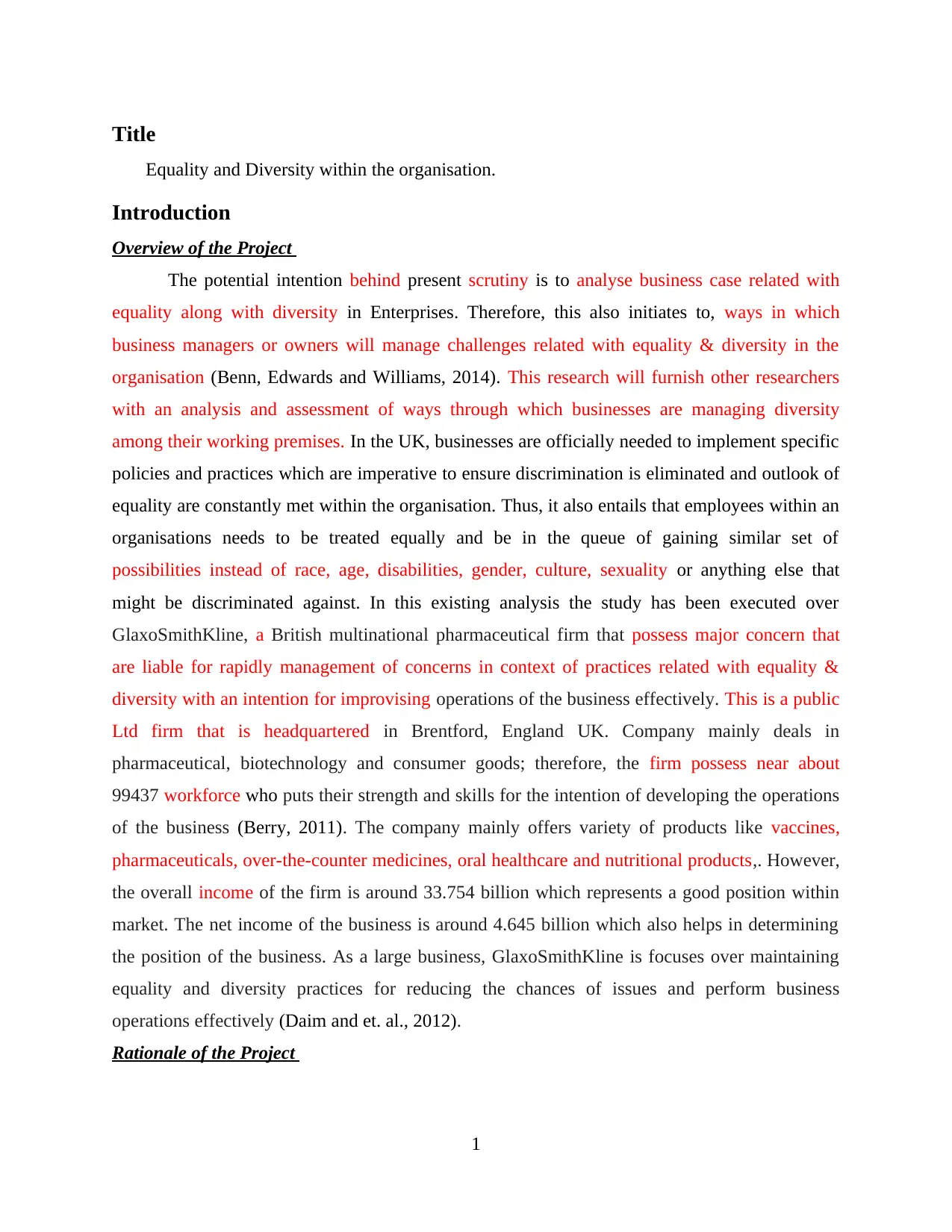
Title
Equality and Diversity within the organisation.
Introduction
Overview of the Project
The potential intention behind present scrutiny is to analyse business case related with
equality along with diversity in Enterprises. Therefore, this also initiates to, ways in which
business managers or owners will manage challenges related with equality & diversity in the
organisation (Benn, Edwards and Williams, 2014). This research will furnish other researchers
with an analysis and assessment of ways through which businesses are managing diversity
among their working premises. In the UK, businesses are officially needed to implement specific
policies and practices which are imperative to ensure discrimination is eliminated and outlook of
equality are constantly met within the organisation. Thus, it also entails that employees within an
organisations needs to be treated equally and be in the queue of gaining similar set of
possibilities instead of race, age, disabilities, gender, culture, sexuality or anything else that
might be discriminated against. In this existing analysis the study has been executed over
GlaxoSmithKline, a British multinational pharmaceutical firm that possess major concern that
are liable for rapidly management of concerns in context of practices related with equality &
diversity with an intention for improvising operations of the business effectively. This is a public
Ltd firm that is headquartered in Brentford, England UK. Company mainly deals in
pharmaceutical, biotechnology and consumer goods; therefore, the firm possess near about
99437 workforce who puts their strength and skills for the intention of developing the operations
of the business (Berry, 2011). The company mainly offers variety of products like vaccines,
pharmaceuticals, over-the-counter medicines, oral healthcare and nutritional products,. However,
the overall income of the firm is around 33.754 billion which represents a good position within
market. The net income of the business is around 4.645 billion which also helps in determining
the position of the business. As a large business, GlaxoSmithKline is focuses over maintaining
equality and diversity practices for reducing the chances of issues and perform business
operations effectively (Daim and et. al., 2012).
Rationale of the Project
1
Equality and Diversity within the organisation.
Introduction
Overview of the Project
The potential intention behind present scrutiny is to analyse business case related with
equality along with diversity in Enterprises. Therefore, this also initiates to, ways in which
business managers or owners will manage challenges related with equality & diversity in the
organisation (Benn, Edwards and Williams, 2014). This research will furnish other researchers
with an analysis and assessment of ways through which businesses are managing diversity
among their working premises. In the UK, businesses are officially needed to implement specific
policies and practices which are imperative to ensure discrimination is eliminated and outlook of
equality are constantly met within the organisation. Thus, it also entails that employees within an
organisations needs to be treated equally and be in the queue of gaining similar set of
possibilities instead of race, age, disabilities, gender, culture, sexuality or anything else that
might be discriminated against. In this existing analysis the study has been executed over
GlaxoSmithKline, a British multinational pharmaceutical firm that possess major concern that
are liable for rapidly management of concerns in context of practices related with equality &
diversity with an intention for improvising operations of the business effectively. This is a public
Ltd firm that is headquartered in Brentford, England UK. Company mainly deals in
pharmaceutical, biotechnology and consumer goods; therefore, the firm possess near about
99437 workforce who puts their strength and skills for the intention of developing the operations
of the business (Berry, 2011). The company mainly offers variety of products like vaccines,
pharmaceuticals, over-the-counter medicines, oral healthcare and nutritional products,. However,
the overall income of the firm is around 33.754 billion which represents a good position within
market. The net income of the business is around 4.645 billion which also helps in determining
the position of the business. As a large business, GlaxoSmithKline is focuses over maintaining
equality and diversity practices for reducing the chances of issues and perform business
operations effectively (Daim and et. al., 2012).
Rationale of the Project
1
Paraphrase This Document
Need a fresh take? Get an instant paraphrase of this document with our AI Paraphraser
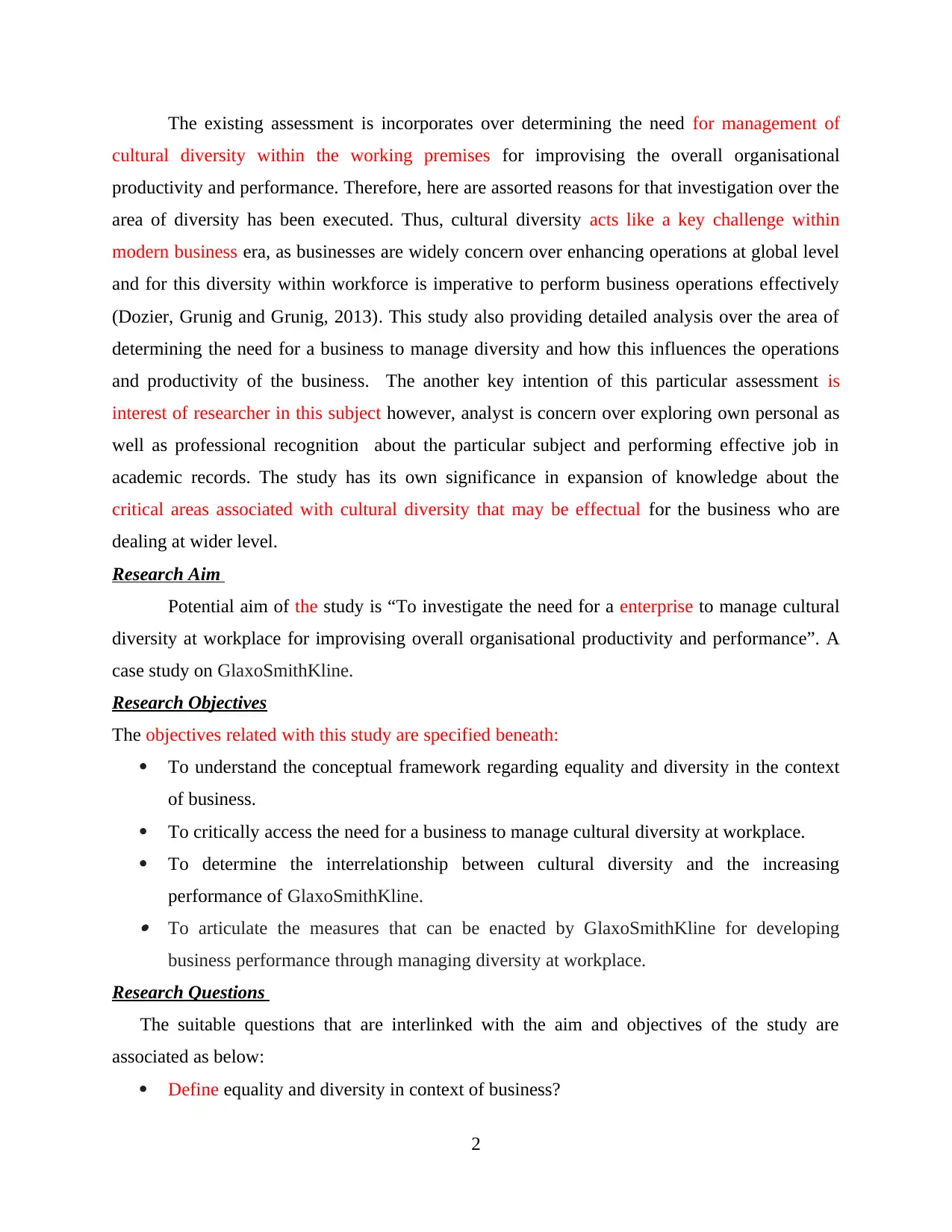
The existing assessment is incorporates over determining the need for management of
cultural diversity within the working premises for improvising the overall organisational
productivity and performance. Therefore, here are assorted reasons for that investigation over the
area of diversity has been executed. Thus, cultural diversity acts like a key challenge within
modern business era, as businesses are widely concern over enhancing operations at global level
and for this diversity within workforce is imperative to perform business operations effectively
(Dozier, Grunig and Grunig, 2013). This study also providing detailed analysis over the area of
determining the need for a business to manage diversity and how this influences the operations
and productivity of the business. The another key intention of this particular assessment is
interest of researcher in this subject however, analyst is concern over exploring own personal as
well as professional recognition about the particular subject and performing effective job in
academic records. The study has its own significance in expansion of knowledge about the
critical areas associated with cultural diversity that may be effectual for the business who are
dealing at wider level.
Research Aim
Potential aim of the study is “To investigate the need for a enterprise to manage cultural
diversity at workplace for improvising overall organisational productivity and performance”. A
case study on GlaxoSmithKline.
Research Objectives
The objectives related with this study are specified beneath:
To understand the conceptual framework regarding equality and diversity in the context
of business.
To critically access the need for a business to manage cultural diversity at workplace.
To determine the interrelationship between cultural diversity and the increasing
performance of GlaxoSmithKline. To articulate the measures that can be enacted by GlaxoSmithKline for developing
business performance through managing diversity at workplace.
Research Questions
The suitable questions that are interlinked with the aim and objectives of the study are
associated as below:
Define equality and diversity in context of business?
2
cultural diversity within the working premises for improvising the overall organisational
productivity and performance. Therefore, here are assorted reasons for that investigation over the
area of diversity has been executed. Thus, cultural diversity acts like a key challenge within
modern business era, as businesses are widely concern over enhancing operations at global level
and for this diversity within workforce is imperative to perform business operations effectively
(Dozier, Grunig and Grunig, 2013). This study also providing detailed analysis over the area of
determining the need for a business to manage diversity and how this influences the operations
and productivity of the business. The another key intention of this particular assessment is
interest of researcher in this subject however, analyst is concern over exploring own personal as
well as professional recognition about the particular subject and performing effective job in
academic records. The study has its own significance in expansion of knowledge about the
critical areas associated with cultural diversity that may be effectual for the business who are
dealing at wider level.
Research Aim
Potential aim of the study is “To investigate the need for a enterprise to manage cultural
diversity at workplace for improvising overall organisational productivity and performance”. A
case study on GlaxoSmithKline.
Research Objectives
The objectives related with this study are specified beneath:
To understand the conceptual framework regarding equality and diversity in the context
of business.
To critically access the need for a business to manage cultural diversity at workplace.
To determine the interrelationship between cultural diversity and the increasing
performance of GlaxoSmithKline. To articulate the measures that can be enacted by GlaxoSmithKline for developing
business performance through managing diversity at workplace.
Research Questions
The suitable questions that are interlinked with the aim and objectives of the study are
associated as below:
Define equality and diversity in context of business?
2
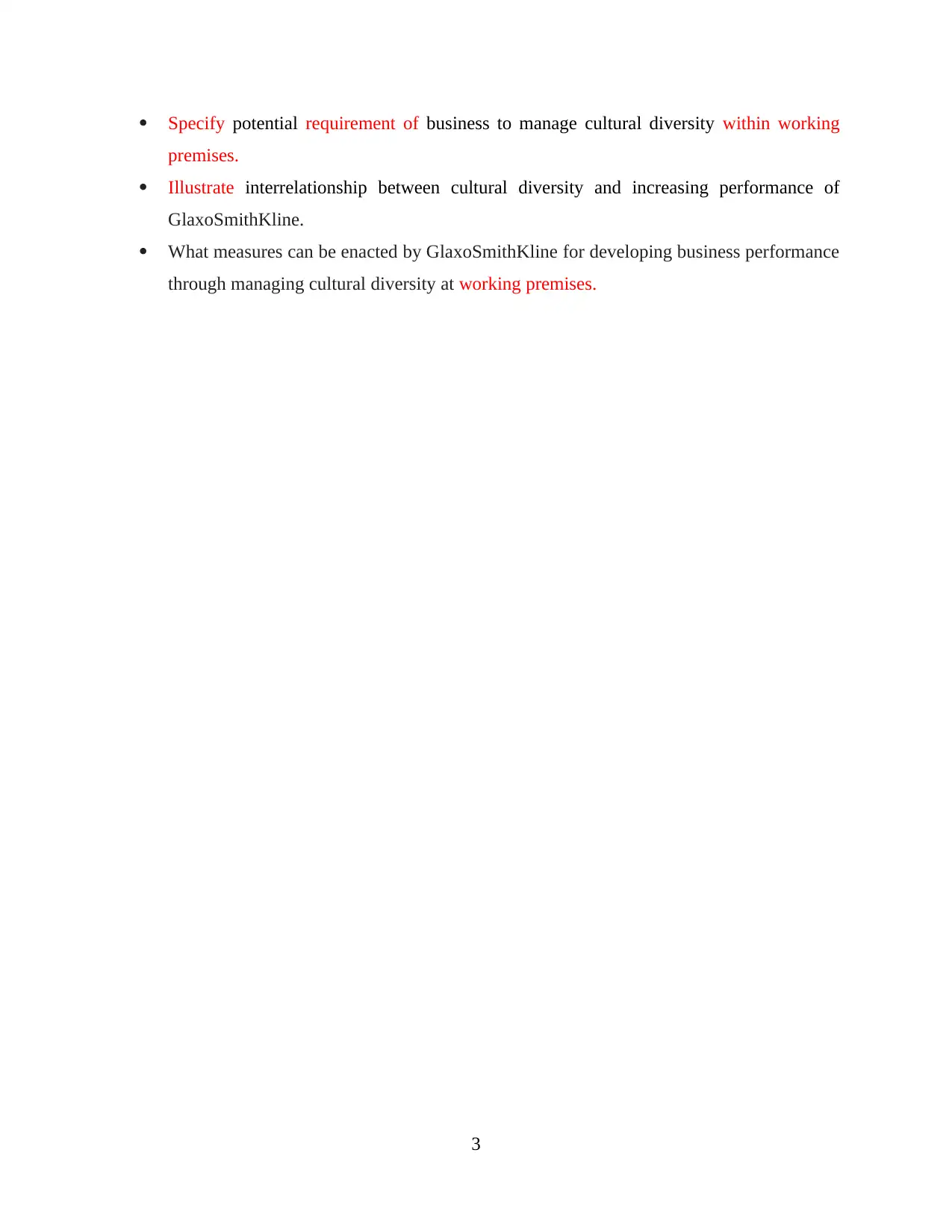
Specify potential requirement of business to manage cultural diversity within working
premises.
Illustrate interrelationship between cultural diversity and increasing performance of
GlaxoSmithKline.
What measures can be enacted by GlaxoSmithKline for developing business performance
through managing cultural diversity at working premises.
3
premises.
Illustrate interrelationship between cultural diversity and increasing performance of
GlaxoSmithKline.
What measures can be enacted by GlaxoSmithKline for developing business performance
through managing cultural diversity at working premises.
3
⊘ This is a preview!⊘
Do you want full access?
Subscribe today to unlock all pages.

Trusted by 1+ million students worldwide
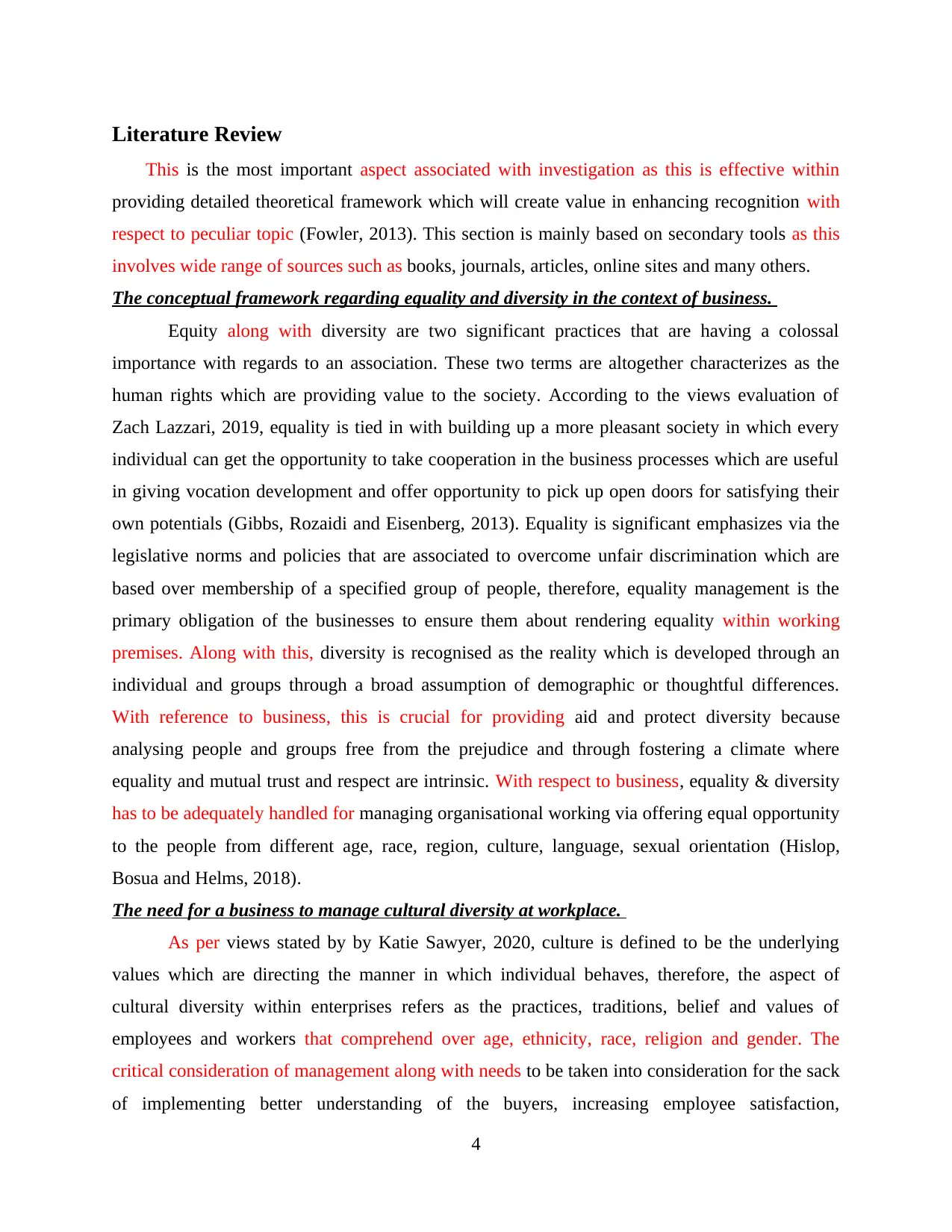
Literature Review
This is the most important aspect associated with investigation as this is effective within
providing detailed theoretical framework which will create value in enhancing recognition with
respect to peculiar topic (Fowler, 2013). This section is mainly based on secondary tools as this
involves wide range of sources such as books, journals, articles, online sites and many others.
The conceptual framework regarding equality and diversity in the context of business.
Equity along with diversity are two significant practices that are having a colossal
importance with regards to an association. These two terms are altogether characterizes as the
human rights which are providing value to the society. According to the views evaluation of
Zach Lazzari, 2019, equality is tied in with building up a more pleasant society in which every
individual can get the opportunity to take cooperation in the business processes which are useful
in giving vocation development and offer opportunity to pick up open doors for satisfying their
own potentials (Gibbs, Rozaidi and Eisenberg, 2013). Equality is significant emphasizes via the
legislative norms and policies that are associated to overcome unfair discrimination which are
based over membership of a specified group of people, therefore, equality management is the
primary obligation of the businesses to ensure them about rendering equality within working
premises. Along with this, diversity is recognised as the reality which is developed through an
individual and groups through a broad assumption of demographic or thoughtful differences.
With reference to business, this is crucial for providing aid and protect diversity because
analysing people and groups free from the prejudice and through fostering a climate where
equality and mutual trust and respect are intrinsic. With respect to business, equality & diversity
has to be adequately handled for managing organisational working via offering equal opportunity
to the people from different age, race, region, culture, language, sexual orientation (Hislop,
Bosua and Helms, 2018).
The need for a business to manage cultural diversity at workplace.
As per views stated by by Katie Sawyer, 2020, culture is defined to be the underlying
values which are directing the manner in which individual behaves, therefore, the aspect of
cultural diversity within enterprises refers as the practices, traditions, belief and values of
employees and workers that comprehend over age, ethnicity, race, religion and gender. The
critical consideration of management along with needs to be taken into consideration for the sack
of implementing better understanding of the buyers, increasing employee satisfaction,
4
This is the most important aspect associated with investigation as this is effective within
providing detailed theoretical framework which will create value in enhancing recognition with
respect to peculiar topic (Fowler, 2013). This section is mainly based on secondary tools as this
involves wide range of sources such as books, journals, articles, online sites and many others.
The conceptual framework regarding equality and diversity in the context of business.
Equity along with diversity are two significant practices that are having a colossal
importance with regards to an association. These two terms are altogether characterizes as the
human rights which are providing value to the society. According to the views evaluation of
Zach Lazzari, 2019, equality is tied in with building up a more pleasant society in which every
individual can get the opportunity to take cooperation in the business processes which are useful
in giving vocation development and offer opportunity to pick up open doors for satisfying their
own potentials (Gibbs, Rozaidi and Eisenberg, 2013). Equality is significant emphasizes via the
legislative norms and policies that are associated to overcome unfair discrimination which are
based over membership of a specified group of people, therefore, equality management is the
primary obligation of the businesses to ensure them about rendering equality within working
premises. Along with this, diversity is recognised as the reality which is developed through an
individual and groups through a broad assumption of demographic or thoughtful differences.
With reference to business, this is crucial for providing aid and protect diversity because
analysing people and groups free from the prejudice and through fostering a climate where
equality and mutual trust and respect are intrinsic. With respect to business, equality & diversity
has to be adequately handled for managing organisational working via offering equal opportunity
to the people from different age, race, region, culture, language, sexual orientation (Hislop,
Bosua and Helms, 2018).
The need for a business to manage cultural diversity at workplace.
As per views stated by by Katie Sawyer, 2020, culture is defined to be the underlying
values which are directing the manner in which individual behaves, therefore, the aspect of
cultural diversity within enterprises refers as the practices, traditions, belief and values of
employees and workers that comprehend over age, ethnicity, race, religion and gender. The
critical consideration of management along with needs to be taken into consideration for the sack
of implementing better understanding of the buyers, increasing employee satisfaction,
4
Paraphrase This Document
Need a fresh take? Get an instant paraphrase of this document with our AI Paraphraser
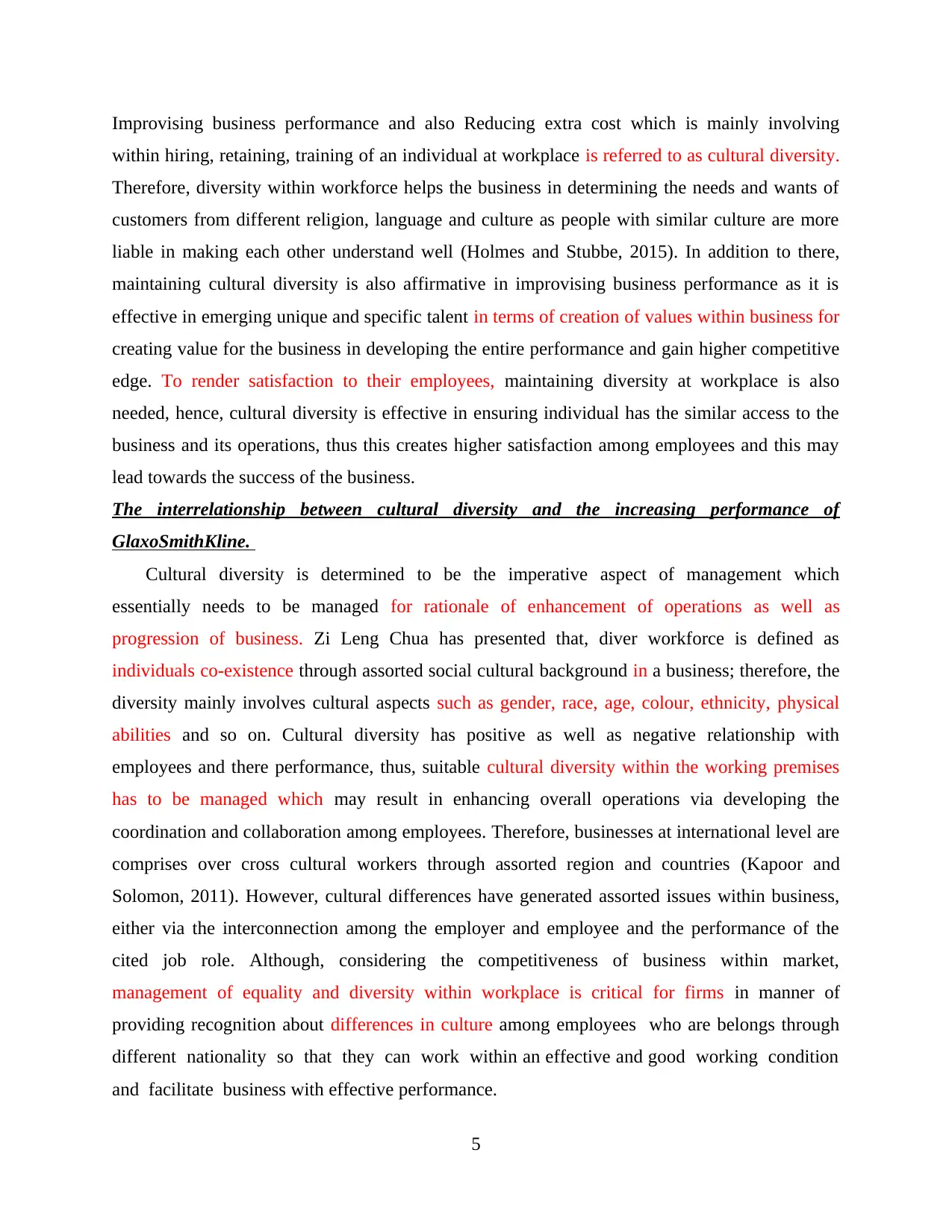
Improvising business performance and also Reducing extra cost which is mainly involving
within hiring, retaining, training of an individual at workplace is referred to as cultural diversity.
Therefore, diversity within workforce helps the business in determining the needs and wants of
customers from different religion, language and culture as people with similar culture are more
liable in making each other understand well (Holmes and Stubbe, 2015). In addition to there,
maintaining cultural diversity is also affirmative in improvising business performance as it is
effective in emerging unique and specific talent in terms of creation of values within business for
creating value for the business in developing the entire performance and gain higher competitive
edge. To render satisfaction to their employees, maintaining diversity at workplace is also
needed, hence, cultural diversity is effective in ensuring individual has the similar access to the
business and its operations, thus this creates higher satisfaction among employees and this may
lead towards the success of the business.
The interrelationship between cultural diversity and the increasing performance of
GlaxoSmithKline.
Cultural diversity is determined to be the imperative aspect of management which
essentially needs to be managed for rationale of enhancement of operations as well as
progression of business. Zi Leng Chua has presented that, diver workforce is defined as
individuals co-existence through assorted social cultural background in a business; therefore, the
diversity mainly involves cultural aspects such as gender, race, age, colour, ethnicity, physical
abilities and so on. Cultural diversity has positive as well as negative relationship with
employees and there performance, thus, suitable cultural diversity within the working premises
has to be managed which may result in enhancing overall operations via developing the
coordination and collaboration among employees. Therefore, businesses at international level are
comprises over cross cultural workers through assorted region and countries (Kapoor and
Solomon, 2011). However, cultural differences have generated assorted issues within business,
either via the interconnection among the employer and employee and the performance of the
cited job role. Although, considering the competitiveness of business within market,
management of equality and diversity within workplace is critical for firms in manner of
providing recognition about differences in culture among employees who are belongs through
different nationality so that they can work within an effective and good working condition
and facilitate business with effective performance.
5
within hiring, retaining, training of an individual at workplace is referred to as cultural diversity.
Therefore, diversity within workforce helps the business in determining the needs and wants of
customers from different religion, language and culture as people with similar culture are more
liable in making each other understand well (Holmes and Stubbe, 2015). In addition to there,
maintaining cultural diversity is also affirmative in improvising business performance as it is
effective in emerging unique and specific talent in terms of creation of values within business for
creating value for the business in developing the entire performance and gain higher competitive
edge. To render satisfaction to their employees, maintaining diversity at workplace is also
needed, hence, cultural diversity is effective in ensuring individual has the similar access to the
business and its operations, thus this creates higher satisfaction among employees and this may
lead towards the success of the business.
The interrelationship between cultural diversity and the increasing performance of
GlaxoSmithKline.
Cultural diversity is determined to be the imperative aspect of management which
essentially needs to be managed for rationale of enhancement of operations as well as
progression of business. Zi Leng Chua has presented that, diver workforce is defined as
individuals co-existence through assorted social cultural background in a business; therefore, the
diversity mainly involves cultural aspects such as gender, race, age, colour, ethnicity, physical
abilities and so on. Cultural diversity has positive as well as negative relationship with
employees and there performance, thus, suitable cultural diversity within the working premises
has to be managed which may result in enhancing overall operations via developing the
coordination and collaboration among employees. Therefore, businesses at international level are
comprises over cross cultural workers through assorted region and countries (Kapoor and
Solomon, 2011). However, cultural differences have generated assorted issues within business,
either via the interconnection among the employer and employee and the performance of the
cited job role. Although, considering the competitiveness of business within market,
management of equality and diversity within workplace is critical for firms in manner of
providing recognition about differences in culture among employees who are belongs through
different nationality so that they can work within an effective and good working condition
and facilitate business with effective performance.
5
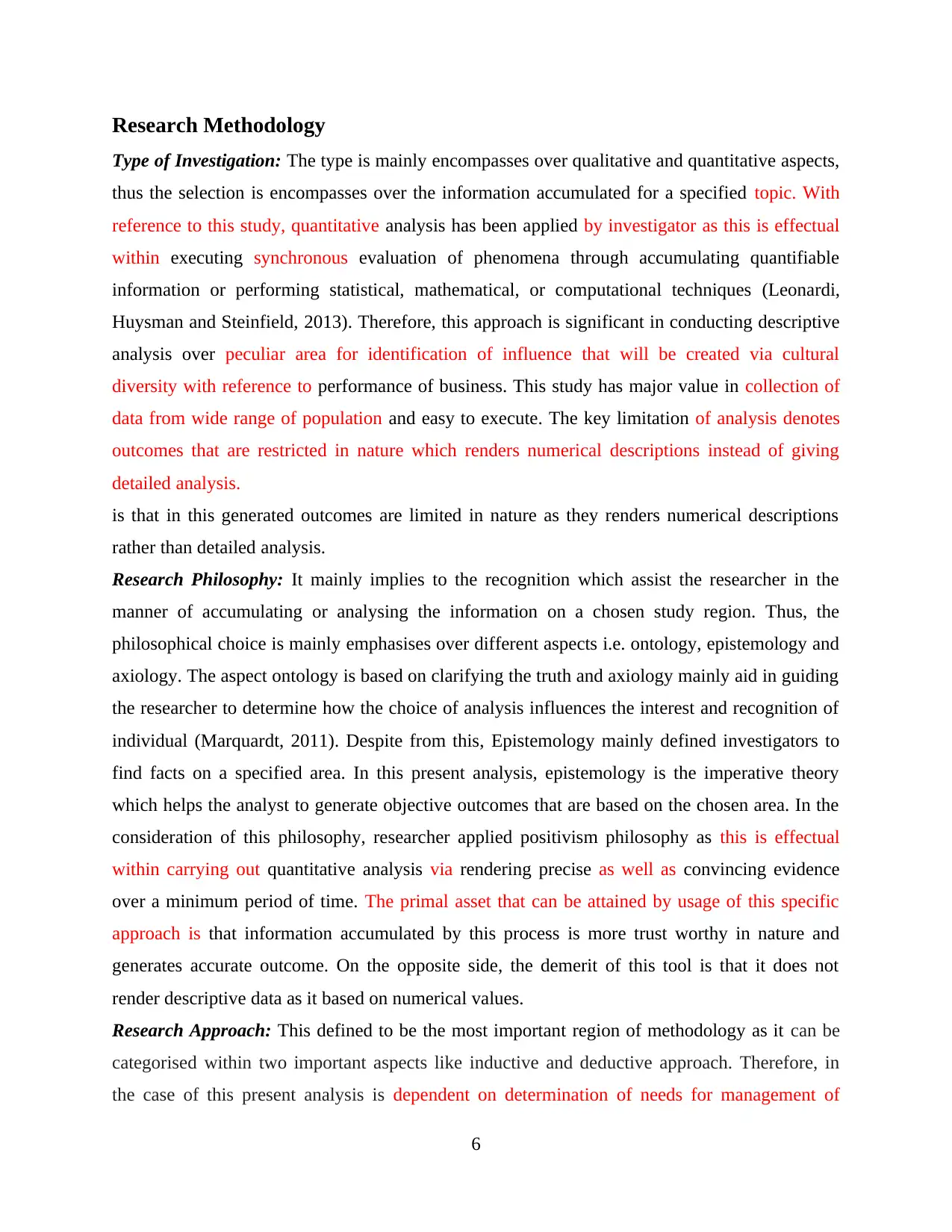
Research Methodology
Type of Investigation: The type is mainly encompasses over qualitative and quantitative aspects,
thus the selection is encompasses over the information accumulated for a specified topic. With
reference to this study, quantitative analysis has been applied by investigator as this is effectual
within executing synchronous evaluation of phenomena through accumulating quantifiable
information or performing statistical, mathematical, or computational techniques (Leonardi,
Huysman and Steinfield, 2013). Therefore, this approach is significant in conducting descriptive
analysis over peculiar area for identification of influence that will be created via cultural
diversity with reference to performance of business. This study has major value in collection of
data from wide range of population and easy to execute. The key limitation of analysis denotes
outcomes that are restricted in nature which renders numerical descriptions instead of giving
detailed analysis.
is that in this generated outcomes are limited in nature as they renders numerical descriptions
rather than detailed analysis.
Research Philosophy: It mainly implies to the recognition which assist the researcher in the
manner of accumulating or analysing the information on a chosen study region. Thus, the
philosophical choice is mainly emphasises over different aspects i.e. ontology, epistemology and
axiology. The aspect ontology is based on clarifying the truth and axiology mainly aid in guiding
the researcher to determine how the choice of analysis influences the interest and recognition of
individual (Marquardt, 2011). Despite from this, Epistemology mainly defined investigators to
find facts on a specified area. In this present analysis, epistemology is the imperative theory
which helps the analyst to generate objective outcomes that are based on the chosen area. In the
consideration of this philosophy, researcher applied positivism philosophy as this is effectual
within carrying out quantitative analysis via rendering precise as well as convincing evidence
over a minimum period of time. The primal asset that can be attained by usage of this specific
approach is that information accumulated by this process is more trust worthy in nature and
generates accurate outcome. On the opposite side, the demerit of this tool is that it does not
render descriptive data as it based on numerical values.
Research Approach: This defined to be the most important region of methodology as it can be
categorised within two important aspects like inductive and deductive approach. Therefore, in
the case of this present analysis is dependent on determination of needs for management of
6
Type of Investigation: The type is mainly encompasses over qualitative and quantitative aspects,
thus the selection is encompasses over the information accumulated for a specified topic. With
reference to this study, quantitative analysis has been applied by investigator as this is effectual
within executing synchronous evaluation of phenomena through accumulating quantifiable
information or performing statistical, mathematical, or computational techniques (Leonardi,
Huysman and Steinfield, 2013). Therefore, this approach is significant in conducting descriptive
analysis over peculiar area for identification of influence that will be created via cultural
diversity with reference to performance of business. This study has major value in collection of
data from wide range of population and easy to execute. The key limitation of analysis denotes
outcomes that are restricted in nature which renders numerical descriptions instead of giving
detailed analysis.
is that in this generated outcomes are limited in nature as they renders numerical descriptions
rather than detailed analysis.
Research Philosophy: It mainly implies to the recognition which assist the researcher in the
manner of accumulating or analysing the information on a chosen study region. Thus, the
philosophical choice is mainly emphasises over different aspects i.e. ontology, epistemology and
axiology. The aspect ontology is based on clarifying the truth and axiology mainly aid in guiding
the researcher to determine how the choice of analysis influences the interest and recognition of
individual (Marquardt, 2011). Despite from this, Epistemology mainly defined investigators to
find facts on a specified area. In this present analysis, epistemology is the imperative theory
which helps the analyst to generate objective outcomes that are based on the chosen area. In the
consideration of this philosophy, researcher applied positivism philosophy as this is effectual
within carrying out quantitative analysis via rendering precise as well as convincing evidence
over a minimum period of time. The primal asset that can be attained by usage of this specific
approach is that information accumulated by this process is more trust worthy in nature and
generates accurate outcome. On the opposite side, the demerit of this tool is that it does not
render descriptive data as it based on numerical values.
Research Approach: This defined to be the most important region of methodology as it can be
categorised within two important aspects like inductive and deductive approach. Therefore, in
the case of this present analysis is dependent on determination of needs for management of
6
⊘ This is a preview!⊘
Do you want full access?
Subscribe today to unlock all pages.

Trusted by 1+ million students worldwide
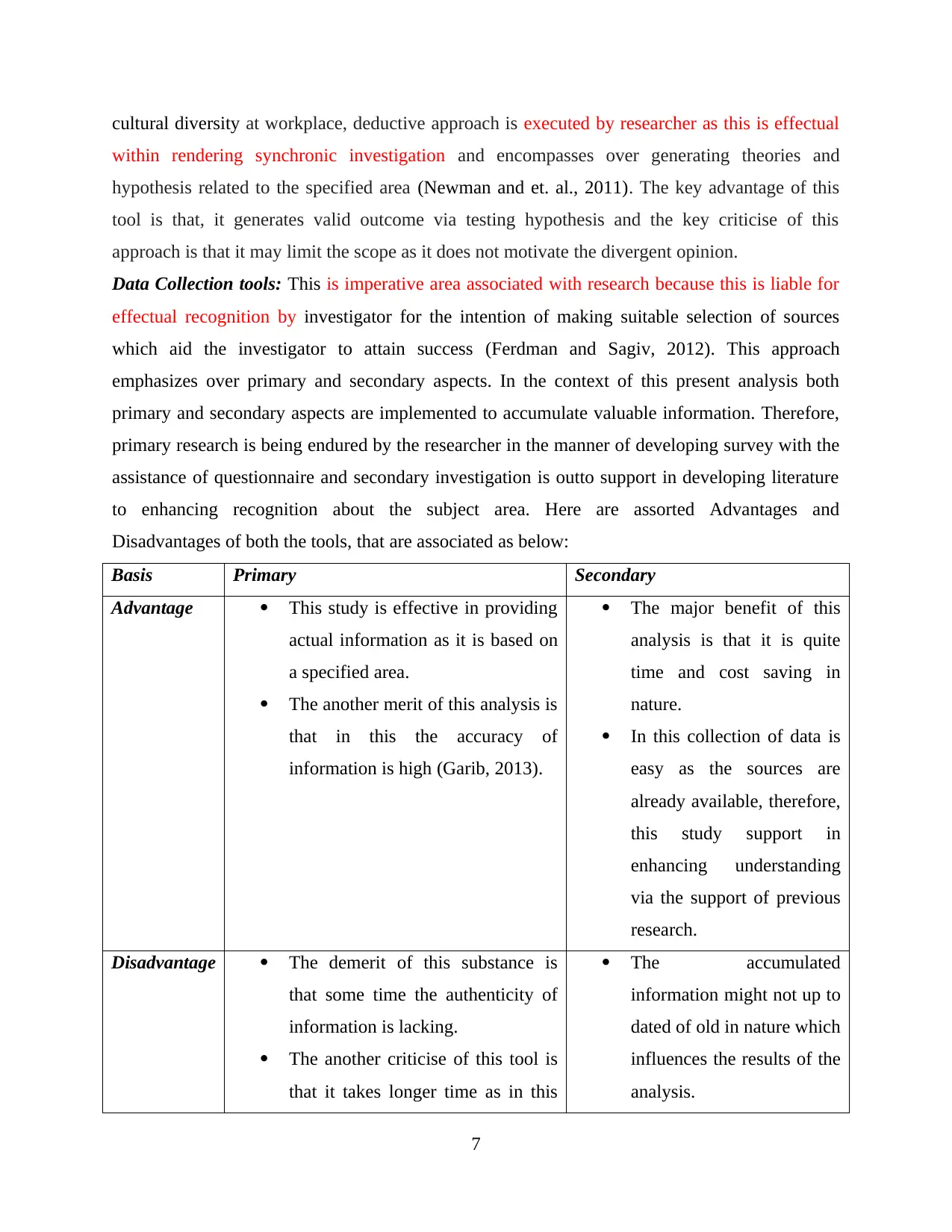
cultural diversity at workplace, deductive approach is executed by researcher as this is effectual
within rendering synchronic investigation and encompasses over generating theories and
hypothesis related to the specified area (Newman and et. al., 2011). The key advantage of this
tool is that, it generates valid outcome via testing hypothesis and the key criticise of this
approach is that it may limit the scope as it does not motivate the divergent opinion.
Data Collection tools: This is imperative area associated with research because this is liable for
effectual recognition by investigator for the intention of making suitable selection of sources
which aid the investigator to attain success (Ferdman and Sagiv, 2012). This approach
emphasizes over primary and secondary aspects. In the context of this present analysis both
primary and secondary aspects are implemented to accumulate valuable information. Therefore,
primary research is being endured by the researcher in the manner of developing survey with the
assistance of questionnaire and secondary investigation is outto support in developing literature
to enhancing recognition about the subject area. Here are assorted Advantages and
Disadvantages of both the tools, that are associated as below:
Basis Primary Secondary
Advantage This study is effective in providing
actual information as it is based on
a specified area.
The another merit of this analysis is
that in this the accuracy of
information is high (Garib, 2013).
The major benefit of this
analysis is that it is quite
time and cost saving in
nature.
In this collection of data is
easy as the sources are
already available, therefore,
this study support in
enhancing understanding
via the support of previous
research.
Disadvantage The demerit of this substance is
that some time the authenticity of
information is lacking.
The another criticise of this tool is
that it takes longer time as in this
The accumulated
information might not up to
dated of old in nature which
influences the results of the
analysis.
7
within rendering synchronic investigation and encompasses over generating theories and
hypothesis related to the specified area (Newman and et. al., 2011). The key advantage of this
tool is that, it generates valid outcome via testing hypothesis and the key criticise of this
approach is that it may limit the scope as it does not motivate the divergent opinion.
Data Collection tools: This is imperative area associated with research because this is liable for
effectual recognition by investigator for the intention of making suitable selection of sources
which aid the investigator to attain success (Ferdman and Sagiv, 2012). This approach
emphasizes over primary and secondary aspects. In the context of this present analysis both
primary and secondary aspects are implemented to accumulate valuable information. Therefore,
primary research is being endured by the researcher in the manner of developing survey with the
assistance of questionnaire and secondary investigation is outto support in developing literature
to enhancing recognition about the subject area. Here are assorted Advantages and
Disadvantages of both the tools, that are associated as below:
Basis Primary Secondary
Advantage This study is effective in providing
actual information as it is based on
a specified area.
The another merit of this analysis is
that in this the accuracy of
information is high (Garib, 2013).
The major benefit of this
analysis is that it is quite
time and cost saving in
nature.
In this collection of data is
easy as the sources are
already available, therefore,
this study support in
enhancing understanding
via the support of previous
research.
Disadvantage The demerit of this substance is
that some time the authenticity of
information is lacking.
The another criticise of this tool is
that it takes longer time as in this
The accumulated
information might not up to
dated of old in nature which
influences the results of the
analysis.
7
Paraphrase This Document
Need a fresh take? Get an instant paraphrase of this document with our AI Paraphraser
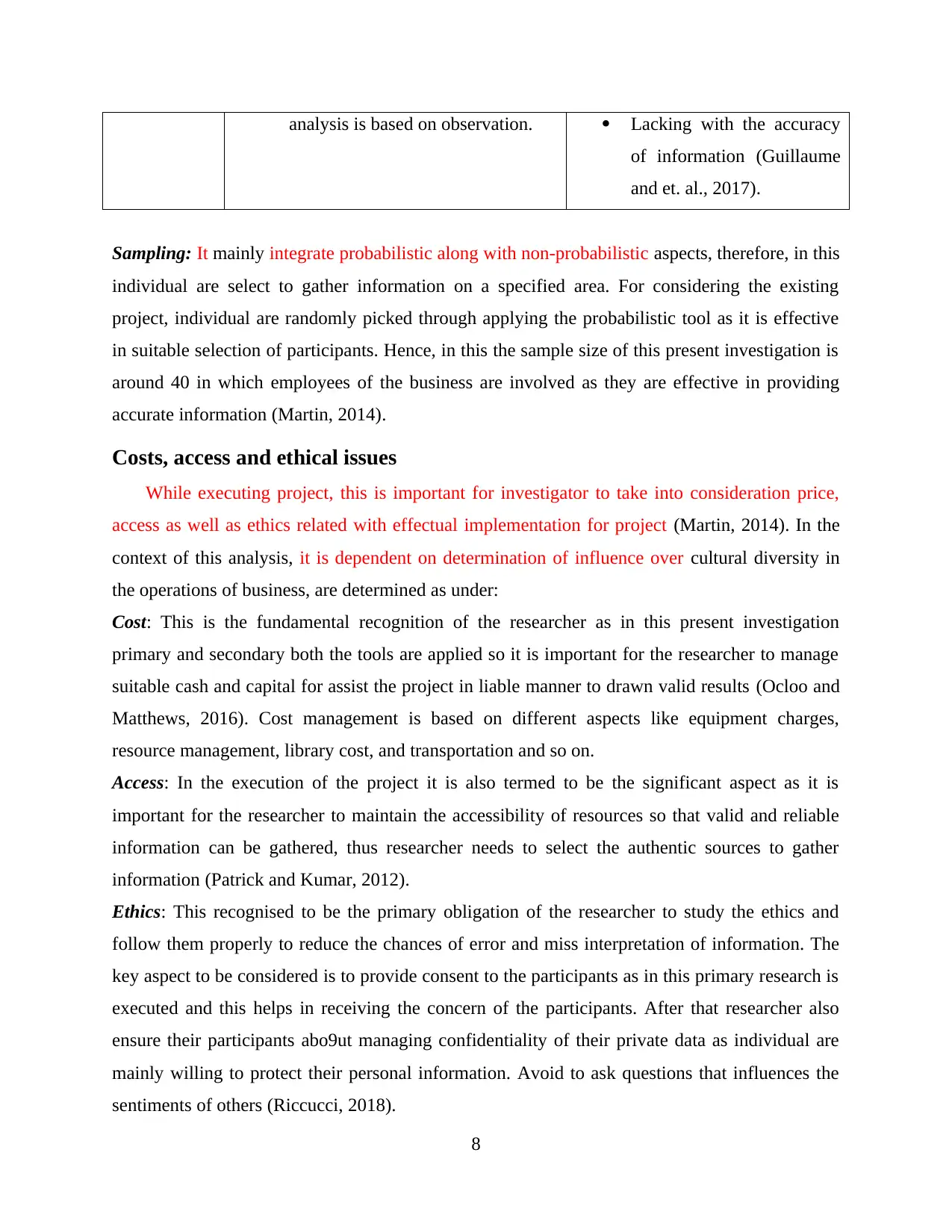
analysis is based on observation. Lacking with the accuracy
of information (Guillaume
and et. al., 2017).
Sampling: It mainly integrate probabilistic along with non-probabilistic aspects, therefore, in this
individual are select to gather information on a specified area. For considering the existing
project, individual are randomly picked through applying the probabilistic tool as it is effective
in suitable selection of participants. Hence, in this the sample size of this present investigation is
around 40 in which employees of the business are involved as they are effective in providing
accurate information (Martin, 2014).
Costs, access and ethical issues
While executing project, this is important for investigator to take into consideration price,
access as well as ethics related with effectual implementation for project (Martin, 2014). In the
context of this analysis, it is dependent on determination of influence over cultural diversity in
the operations of business, are determined as under:
Cost: This is the fundamental recognition of the researcher as in this present investigation
primary and secondary both the tools are applied so it is important for the researcher to manage
suitable cash and capital for assist the project in liable manner to drawn valid results (Ocloo and
Matthews, 2016). Cost management is based on different aspects like equipment charges,
resource management, library cost, and transportation and so on.
Access: In the execution of the project it is also termed to be the significant aspect as it is
important for the researcher to maintain the accessibility of resources so that valid and reliable
information can be gathered, thus researcher needs to select the authentic sources to gather
information (Patrick and Kumar, 2012).
Ethics: This recognised to be the primary obligation of the researcher to study the ethics and
follow them properly to reduce the chances of error and miss interpretation of information. The
key aspect to be considered is to provide consent to the participants as in this primary research is
executed and this helps in receiving the concern of the participants. After that researcher also
ensure their participants abo9ut managing confidentiality of their private data as individual are
mainly willing to protect their personal information. Avoid to ask questions that influences the
sentiments of others (Riccucci, 2018).
8
of information (Guillaume
and et. al., 2017).
Sampling: It mainly integrate probabilistic along with non-probabilistic aspects, therefore, in this
individual are select to gather information on a specified area. For considering the existing
project, individual are randomly picked through applying the probabilistic tool as it is effective
in suitable selection of participants. Hence, in this the sample size of this present investigation is
around 40 in which employees of the business are involved as they are effective in providing
accurate information (Martin, 2014).
Costs, access and ethical issues
While executing project, this is important for investigator to take into consideration price,
access as well as ethics related with effectual implementation for project (Martin, 2014). In the
context of this analysis, it is dependent on determination of influence over cultural diversity in
the operations of business, are determined as under:
Cost: This is the fundamental recognition of the researcher as in this present investigation
primary and secondary both the tools are applied so it is important for the researcher to manage
suitable cash and capital for assist the project in liable manner to drawn valid results (Ocloo and
Matthews, 2016). Cost management is based on different aspects like equipment charges,
resource management, library cost, and transportation and so on.
Access: In the execution of the project it is also termed to be the significant aspect as it is
important for the researcher to maintain the accessibility of resources so that valid and reliable
information can be gathered, thus researcher needs to select the authentic sources to gather
information (Patrick and Kumar, 2012).
Ethics: This recognised to be the primary obligation of the researcher to study the ethics and
follow them properly to reduce the chances of error and miss interpretation of information. The
key aspect to be considered is to provide consent to the participants as in this primary research is
executed and this helps in receiving the concern of the participants. After that researcher also
ensure their participants abo9ut managing confidentiality of their private data as individual are
mainly willing to protect their personal information. Avoid to ask questions that influences the
sentiments of others (Riccucci, 2018).
8
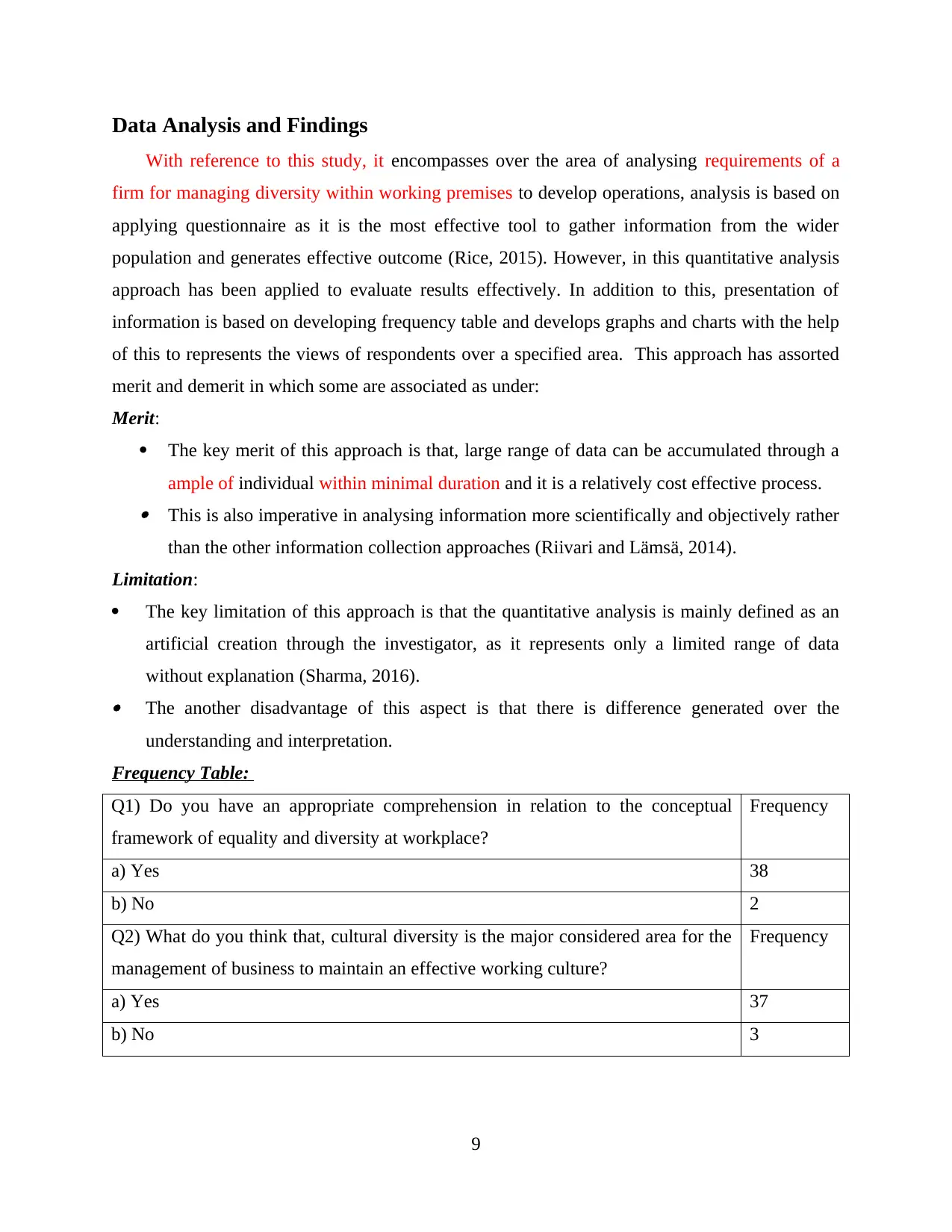
Data Analysis and Findings
With reference to this study, it encompasses over the area of analysing requirements of a
firm for managing diversity within working premises to develop operations, analysis is based on
applying questionnaire as it is the most effective tool to gather information from the wider
population and generates effective outcome (Rice, 2015). However, in this quantitative analysis
approach has been applied to evaluate results effectively. In addition to this, presentation of
information is based on developing frequency table and develops graphs and charts with the help
of this to represents the views of respondents over a specified area. This approach has assorted
merit and demerit in which some are associated as under:
Merit:
The key merit of this approach is that, large range of data can be accumulated through a
ample of individual within minimal duration and it is a relatively cost effective process. This is also imperative in analysing information more scientifically and objectively rather
than the other information collection approaches (Riivari and Lämsä, 2014).
Limitation:
The key limitation of this approach is that the quantitative analysis is mainly defined as an
artificial creation through the investigator, as it represents only a limited range of data
without explanation (Sharma, 2016). The another disadvantage of this aspect is that there is difference generated over the
understanding and interpretation.
Frequency Table:
Q1) Do you have an appropriate comprehension in relation to the conceptual
framework of equality and diversity at workplace?
Frequency
a) Yes 38
b) No 2
Q2) What do you think that, cultural diversity is the major considered area for the
management of business to maintain an effective working culture?
Frequency
a) Yes 37
b) No 3
9
With reference to this study, it encompasses over the area of analysing requirements of a
firm for managing diversity within working premises to develop operations, analysis is based on
applying questionnaire as it is the most effective tool to gather information from the wider
population and generates effective outcome (Rice, 2015). However, in this quantitative analysis
approach has been applied to evaluate results effectively. In addition to this, presentation of
information is based on developing frequency table and develops graphs and charts with the help
of this to represents the views of respondents over a specified area. This approach has assorted
merit and demerit in which some are associated as under:
Merit:
The key merit of this approach is that, large range of data can be accumulated through a
ample of individual within minimal duration and it is a relatively cost effective process. This is also imperative in analysing information more scientifically and objectively rather
than the other information collection approaches (Riivari and Lämsä, 2014).
Limitation:
The key limitation of this approach is that the quantitative analysis is mainly defined as an
artificial creation through the investigator, as it represents only a limited range of data
without explanation (Sharma, 2016). The another disadvantage of this aspect is that there is difference generated over the
understanding and interpretation.
Frequency Table:
Q1) Do you have an appropriate comprehension in relation to the conceptual
framework of equality and diversity at workplace?
Frequency
a) Yes 38
b) No 2
Q2) What do you think that, cultural diversity is the major considered area for the
management of business to maintain an effective working culture?
Frequency
a) Yes 37
b) No 3
9
⊘ This is a preview!⊘
Do you want full access?
Subscribe today to unlock all pages.

Trusted by 1+ million students worldwide
1 out of 29
Related Documents
Your All-in-One AI-Powered Toolkit for Academic Success.
+13062052269
info@desklib.com
Available 24*7 on WhatsApp / Email
![[object Object]](/_next/static/media/star-bottom.7253800d.svg)
Unlock your academic potential
Copyright © 2020–2025 A2Z Services. All Rights Reserved. Developed and managed by ZUCOL.





